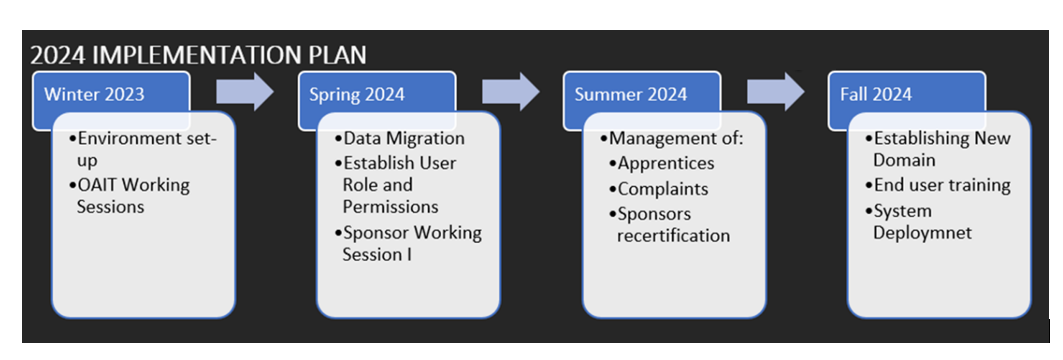THE IMPLEMENTATION OF DCAMS MODERNIZATION PROJECT
-
The District of Columbia Apprenticeship Management System (DCAMS) is a decades old legacy system with limited features to capture all apprentice’s related information. DCAMS has data integrity related issues and other data quality concerns stem from multiple rounds of data migration from previous databases. Therefore, the Office of Apprenticeship, Information and Training (OAIT) has acquired a solution to modernize our technological infrastructure. This new solution is a web-based application that meets today’s needs of the apprenticeship program for years to come.
-
The goal of the project is to replace the current legacy system, DCAMS, with a new web-enabled, robust, and secure technological platform that meets the current and emerging needs of the Office of Apprenticeship, Information, and Training (OAIT), sponsors, Intermediaries, and other vendors. The modernization project aims at improving data validity, accuracy, and stability of the system. The project will enhance the operation efficiency of OAIT and external partners and offer better customer service experience for all stakeholders.
- Improve the functional operation, tracking, and management of apprentices and registered apprenticeship programs.
- Maintain records of approved trades, wage records, and grant related records.
- Strengthen the submission and resolution of apprenticeship related complaints.
- Enhance data accuracy through field level requirements, especially date related fields.
- Prevent duplicate records and the submission of incomplete apprenticeship agreements through Apprentice profiles.
- Improve data quality by preventing outliers and enforcing system constraint.
- Maintain editing capability until the apprenticeship agreement is approved.
- Maintain the management of user’s role-based access and permission.
- Track the progress and completion of the required:
- The hierarchizations of relationships among OAIT, intermediaries, sponsors, and employers’ affiliation with approved programs.
- Incorporate the list of NAICS code numbers for all registered apprenticeship programs (RAP) to meet the RAPIDS report requirement.
- Establish need-based access to ATRs to review and manage assigned sponsors and their respective apprentices, not the entire list of sponsors.
- Incorporate O*NET code number for trades of apprentice-able occupations.
- A dedicated section for the District of Columbia Apprenticeship Council (DCAC) and its members, including their biography and terms of services.
- Sponsors application submission and approval process mechanism.
- Integrate the Registered Apprenticeship Partners Information Database System (RAPIDS) to enable OAIT to submit reports to the Department of Labor.
- Integrate DCAMS with FORRS through employers FEIN to facilitate the Realtime tracking of First Source Projects and strengthen institutional capability for the enforcement of compliance to the district mandated apprenticeship laws on contractors working on District government-financed projects.
- Integrate DCAMS with DC Networks to track the records of pre apprentices that have enrolled into a full fledge apprenticeship program.
Upon successfully implementation, the modernization project is expected to:
1. Enhance or improve the operation capabilities of existing DCAMS features in the management of apprentices and sponsors: Improving existing
Improving data quality and integrity:
2. Introduce new features to respond to current and emerging needs of all apprenticeship stakeholders:
i) On the job training (OJT)
ii) Related technical instruction (RTI)
iii) Performance report of the apprentices in real time.
3. Data integration and synchronization:
4. Automated alerts and communications
The new platform will have system-generated email notifications to facilitate effective communication between the ATR and the sponsor. The ATRs would have a capability to either approve or return an apprentice agreement submitted by sponsors for correction, should the agreement contain incomplete information. Similarly, system generated alerts would serve as notification for approving newly submitted agreements and complete apprentice’s status when completion date become due and serve as notification for upcoming compliance tasks.- DOES OAIT staff and leadership
- OIT technical staff
- Intermediaries
- Sponsors
- Apprentice
- External Partners
- Other DOES designated staff and vendors.
A working group under the name of “DCAMS Refresh Champions” will be established to assist the smooth implementation of the project. The group will be composed of selected stakeholders and will conduct User Acceptance Testing and offer feedback and suggestions on project implementation.
The following diagram shows the initial timeline for the implementation of the project. The diagram highlights the critical milestones of implementation. Nevertheless, depending on need and progress, the suggested implementation timeline could be adjusted to accommodate new and emerging needs, including the time of full transition into the new system.

The new system will be accessible on any desktop, laptop, tablet or mobile device with access to internet. Special technological service or software requirement to use the new platform is not necessary. Therefore, there are no costs for end-users (sponsors or apprentice) to access and utilize the new system. In addition, there are not programs to download on your workstation to access the new system.
• DOES has contracted with a vendor to procure the off-the-shelf product and customize the solution. The Off-the-Shelf product is ApprentiScope. The implementation team includes ApprentiScope staff and OIT contractors.
• OIT will collaborate and engage the vendor on technical matters of the project.
• OAIT will collaborate with OIT and the vendor about specifying program needs.
There is not any known risk that will emanate from implementing the new project. The new platform, when it became operational, is expected to have a similar effect as current navigation of DCAMS.
The Implementation Team will develop training material and deliver necessary training for all stakeholders and end-users, including intermediaries, sponsors, and employers. A reference manual to enable all end-users to know how to navigate and utilize the new system will also be created.


